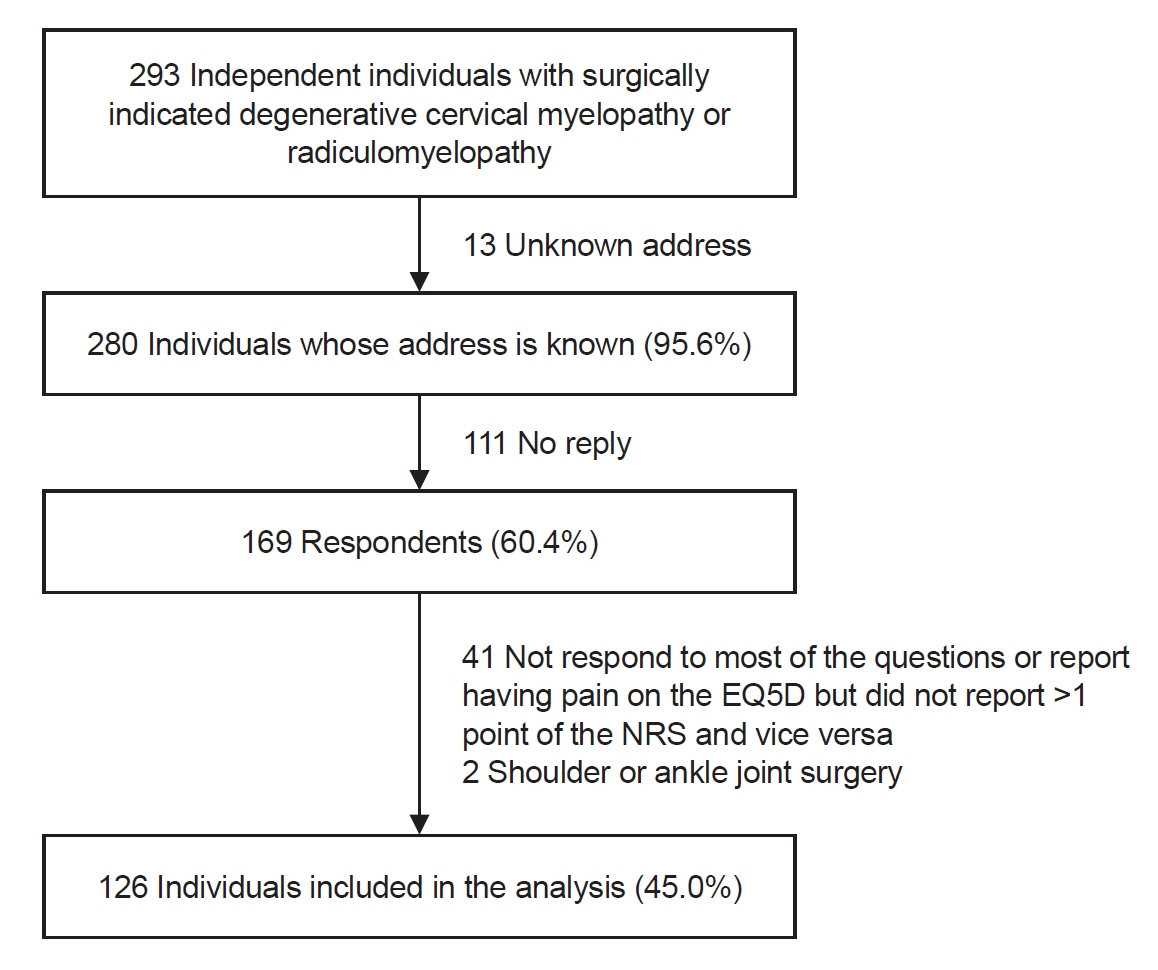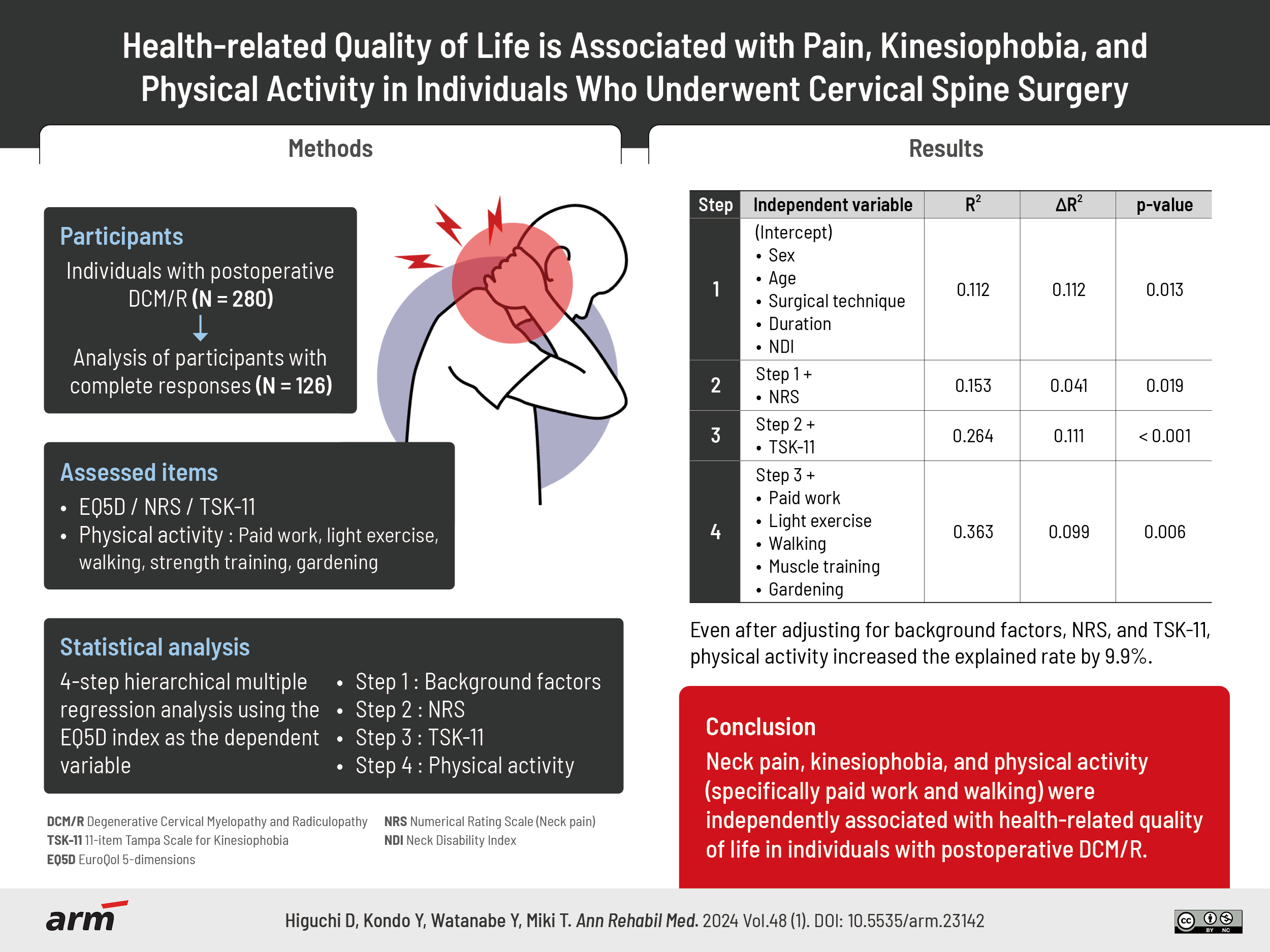Ann Rehabil Med.
2024 Feb;48(1):57-64. 10.5535/arm.23142.
Health-Related Quality of Life is Associated With Pain, Kinesiophobia, and Physical Activity in Individuals Who Underwent Cervical Spine Surgery
- Affiliations
-
- 1Department of Health Care, Takasaki University of Health and Welfare, Takasaki, Japan
- 2Department of Rehabilitation, Sapporo Maruyama Orthopedic Hospital, Sapporo, Japan
- 3PREVENT Inc., Nagoya, Japan
- KMID: 2553162
- DOI: http://doi.org/10.5535/arm.23142
Abstract
Objective
To determine the association between health-related quality of life (HRQOL) and neck pain, kinesiophobia, and modalities of physical activity in individuals with postoperative degenerative cervical myelopathy and radiculopathy (DCM/R) because postoperative pain after cervical spine surgery is likely to persist, causing kinesiophobia and avoidance of physical activity.
Methods
A questionnaire was distributed to 280 individuals with DCM/R. The questionnaire comprised the following four items: HRQOL (EuroQol 5-dimensions 5-level), neck pain (numerical rating scale [NRS]), kinesiophobia (11-item Tampa Scale for Kinesiophobia [TSK-11]), and physical activity (paid work, light exercise, walking, strength training, and gardening). Hierarchical multiple regression analysis was performed using the NRS, TSK-11, and physical activity as independent variables.
Results
In total, 126 individuals provided analyzable responses (45.0%). After including the NRS score as an independent variable to the multiple regression equation for participants’ background, the independent rate of the regression equation significantly improved by only 4.1% (R2=0.153). The addition of the TSK-11 score significantly improved this effect by 11.1% (R2=0.264). Finally, the addition of physical activity also significantly improved the explanatory rate by 9.9% (R2=0.363).
Conclusion
Neck pain, kinesiophobia, and physical activity (specifically paid work and walking) were independently associated with HRQOL in individuals with postoperative DCM/R.
Figure
Reference
-
1. Cohen SP. Epidemiology, diagnosis, and treatment of neck pain. Mayo Clin Proc. 2015; 90:284–99.2. Baucher G, Taskovic J, Troude L, Molliqaj G, Nouri A, Tessitore E. Risk factors for the development of degenerative cervical myelopathy: a review of the literature. Neurosurg Rev. 2022; 45:1675–89.3. Machino M, Ando K, Kobayashi K, Nakashima H, Morozumi M, Kanbara S, et al. Impact of neck and shoulder pain on health-related quality of life in a middle-aged community-living population. Biomed Res Int. 2021; 2021:6674264.4. Wagner A, Shiban Y, Zeller L, Aftahy K, Lange N, Motov S, et al. Psychological predictors of quality of life after anterior cervical discectomy and fusion for degenerative cervical spine disease. Sci Rep. 2020; 10:13415.5. Iizuka Y, Iizuka H, Mieda T, Tsunoda D, Sasaki T, Tajika T, et al. Prevalence of chronic nonspecific low back pain and its associated factors among middle-aged and elderly people: an analysis based on data from a musculoskeletal examination in Japan. Asian Spine J. 2017; 11:989–97.6. Yanardag M, Şimşek TT, Yanardag F. Exploring the relationship of pain, balance, gait function, and quality of life in older adults with hip and knee pain. Pain Manag Nurs. 2021; 22:503–8.7. Rodriguez C, Ji M, Wang HL, Padhya T, McMillan SC. Cancer pain and quality of life. J Hosp Palliat Nurs. 2019; 21:116–23.8. Raymaekers V, Bamps S, Duyvendak W, Put E, Roosen G, Vanvolsem S, et al. Real world data collection and cluster analysis in patients with sciatica due to lumbar disc herniation. Clin Neurol Neurosurg. 2022; 217:107246.9. Kimura A, Shiraishi Y, Inoue H, Endo T, Takeshita K. Predictors of persistent axial neck pain after cervical laminoplasty. Spine (Phila Pa 1976). 2018; 43:10–5.10. Wideman TH, Asmundson GGJ, Smeets RJEM, Zautra AJ, Simmonds MJ, Sullivan MJL, et al. Rethinking the fear avoidance model: toward a multidimensional framework of pain-related disability. Pain. 2013; 154:2262–5.11. Tripp DA, Abraham E, Lambert M, Wagg K, Bigney E, Daly E, et al. Biopsychosocial factors predict quality of life in thoracolumbar spine surgery. Qual Life Res. 2017; 26:3099–110.12. Archer KR, Devin CJ, Vanston SW, Koyama T, Phillips SE, Mathis SL, et al. Cognitive-behavioral-based physical therapy for patients with chronic pain undergoing lumbar spine surgery: a randomized controlled trial. J Pain 2016;17:76-89. Erratum in: J Pain. 2017; 18:477.13. Stagl JM, Antoni MH, Lechner SC, Carver CS, Lewis JE. Postsurgical physical activity and fatigue-related daily interference in women with non-metastatic breast cancer. Psychol Health. 2014; 29:177–98.14. Lin Y, Wu C, He C, Yan J, Chen Y, Gao L, et al. Effectiveness of three exercise programs and intensive follow-up in improving quality of life, pain, and lymphedema among breast cancer survivors: a randomized, controlled 6-month trial. Support Care Cancer. 2022; 31:9.15. Flink IK, Reme S, Jacobsen HB, Glombiewski J, Vlaeyen JWS, Nicholas MK, et al. Pain psychology in the 21st century: lessons learned and moving forward. Scand J Pain. 2020; 20:229–38.16. Kondo Y, Higuchi D, Miki T, Watanabe Y, Takebayashi T. Influence of pain self-efficacy and gender on disability in postoperative cervical myelopathy. Pain Manag Nurs. 2023; 24:335–41.17. Takeshita K, Hosono N, Kawaguchi Y, Hasegawa K, Isomura T, Oshima Y, et al. Validity, reliability and responsiveness of the Japanese version of the Neck Disability Index. J Orthop Sci. 2013; 18:14–21.18. DeVine J, Norvell DC, Ecker E, Fourney DR, Vaccaro A, Wang J, et al. Evaluating the correlation and responsiveness of patient-reported pain with function and quality-of-life outcomes after spine surgery. Spine (Phila Pa 1976). 2011; 36(21 Suppl):S69–74.19. EQ-5D. Terminology [Internet]. EQ-5D; 2022 [cited 2023 Jun 29]. Available from: https://euroqol.org/support/terminology/.20. Alghadir AH, Anwer S, Iqbal A, Iqbal ZA. Test-retest reliability, validity, and minimum detectable change of visual analog, numerical rating, and verbal rating scales for measurement of osteoarthritic knee pain. J Pain Res. 2018; 11:851–6.21. Archer KR, Phelps KD, Seebach CL, Song Y, Riley LH 3rd, Wegener ST. Comparative study of short forms of the Tampa Scale for Kinesiophobia: fear of movement in a surgical spine population. Arch Phys Med Rehabil. 2012; 93:1460–2.22. Higuchi D, Watanabe Y, Kondo Y, Miki T. Validation of a model predicting that physical activities improve health-related quality of life in older Japanese adults with pain, dysesthesia, and kinesiophobia after lumbar surgery: structural equation modeling. Pain Res Manag. 2022; 2022:4147497.23. Pan S, Chen S. Empirical comparison of imputation methods for multivariate missing data in public health. Int J Environ Res Public Health. 2023; 20:1524.24. Andridge RR, Little RJ. A review of hot deck imputation for survey non-response. Int Stat Rev. 2010; 78:40–64.25. United States Census Bureau. Data editing and imputation [Internet]. United States Census Bureau;2022 [cited 2023 Aug 15]. Available from: https://www.census.gov/programs-surveys/sipp/methodology/data-editing-and-imputation.html.26. Chiou CP, Bai YL, Lai LY, Hsieh HC, Chang ST. Hierarchical multiple regression investigating factors associated with depressive symptoms in the middle-aged and elderly undergoing haemodialysis. BMC Public Health. 2023; 23:237.27. Revesz DF, Charalampidis A, Gerdhem P. Effectiveness of laminectomy with fusion and laminectomy alone in degenerative cervical myelopathy. Eur Spine J. 2022; 31:1300–8.28. Gulati S, Vangen-Lønne V, Nygaard ØP, Gulati AM, Hammer TA, Johansen TO, et al. Surgery for degenerative cervical myelopathy: a nationwide registry-based observational study with patient-reported outcomes. Neurosurgery 2021;89:704-11. Erratum in: Neurosurgery. 2021; 89:943.29. McCaffrey N, Kaambwa B, Currow DC, Ratcliffe J. Health-related quality of life measured using the EQ-5D-5L: South Australian population norms. Health Qual Life Outcomes. 2016; 14:133.30. Agnus Tom A, Rajkumar E, John R, Joshua George A. Determinants of quality of life in individuals with chronic low back pain: a systematic review. Health Psychol Behav Med. 2022; 10:124–44.31. Al-Amiry B, Rahim A, Knutsson B, Mattisson L, Sayed-Noor A. Kinesiophobia and its association with functional outcome and quality of life 6-8 years after total hip arthroplasty. Acta Orthop Traumatol Turc. 2022; 56:252–5.32. Wilke C, Ashton P, Elis T, Biallas B, Froböse I. Analysis of work ability and work-related physical activity of employees in a medium-sized business. BMC Res Notes. 2015; 8:803.33. Laucis NC, Hays RD, Bhattacharyya T. Scoring the SF-36 in orthopaedics: a brief guide. J Bone Joint Surg Am. 2015; 97:1628–34.
- Full Text Links
- Actions
-
Cited
- CITED
-
- Close
- Share
- Similar articles
-
- An investigation of the relationship between cutaneous allodynia and kinesiophobia, gastrointestinal system symptom severity, physical activity and disability in individuals with migraine
- The Relation of Physical Activity to Helath Related Quality of Life
- Concepts and Techniques to Prevent Cervical Spine Deformity After Spine Surgery: A Narrative Review
- Correlation between Short-Form 36 Scores and Neck Disability Index in Patients Undergoing Anterior Cervical Discectomy and Fusion
- Association of Weight Change and Physical Activity with Knee Pain and Health-Related Quality of Life in East Asian Women Aged 50 Years and Older with Knee Osteoarthritis: A Population-Based Study



